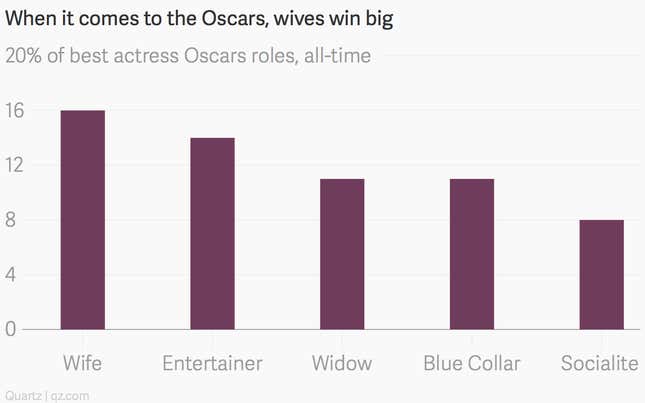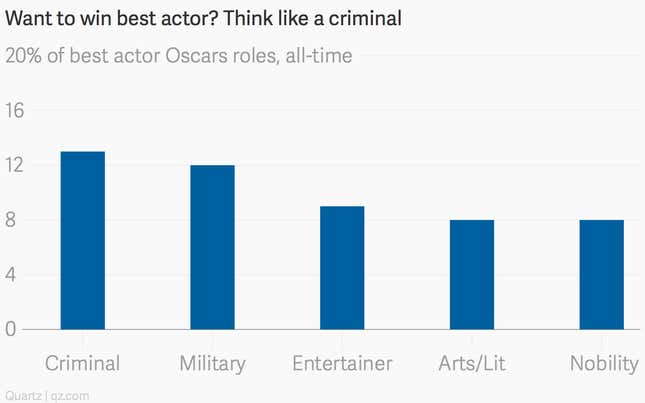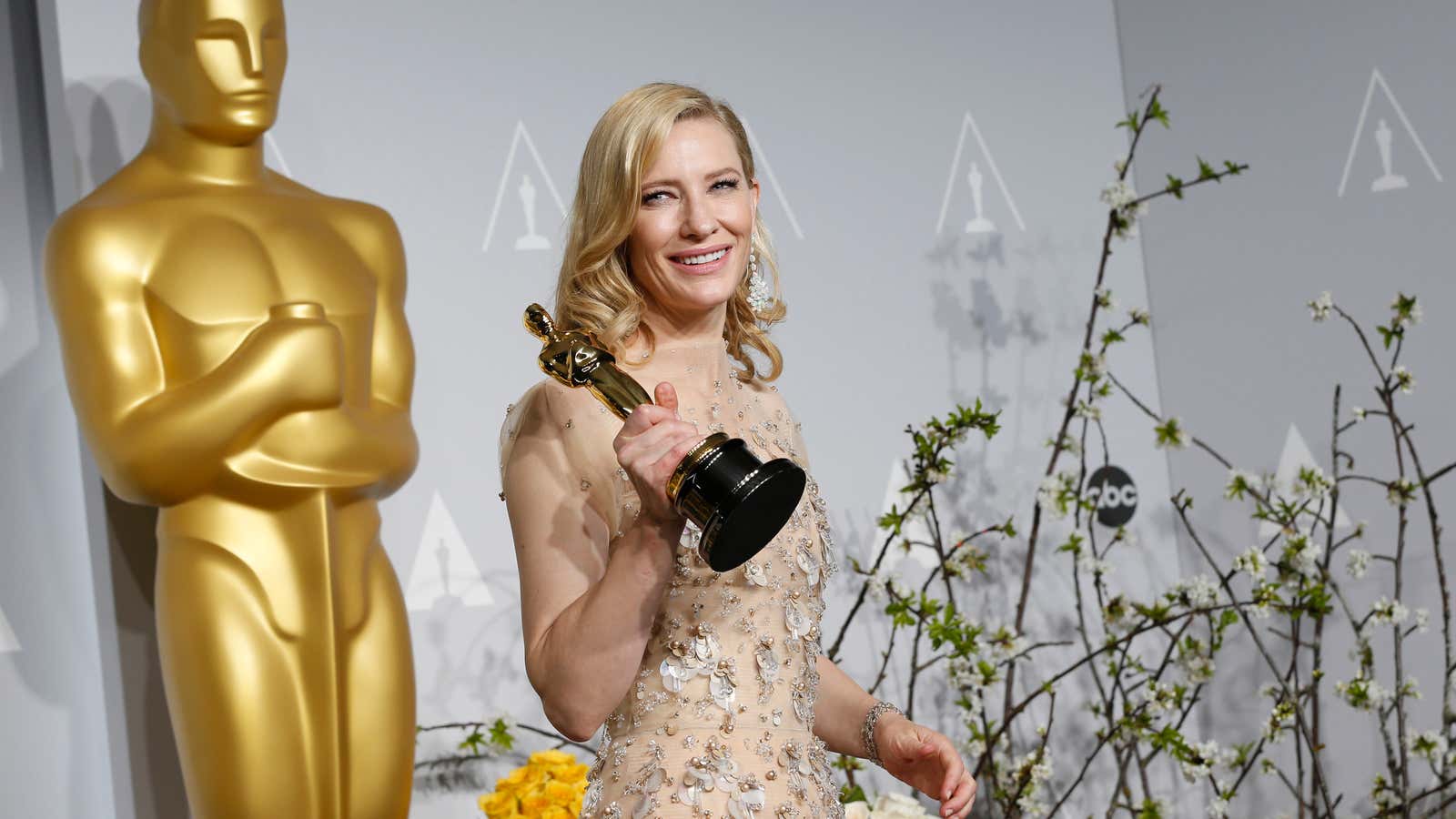Oscars rage is once again rampant. People are mad about the homogeneity, the pageantry, the lack of racial diversity and, yes, the treatment of women. There is a cacophony of voices that say the Oscars don’t matter, but as long as we continue to talk about them, they obviously do.
This year seems to have struck a sensitive chord, however, particularly in terms of the Academy’s treatment of women. There is Ava DuVernay’s directing snub for Selma, the grim reality that not one woman was nominated in the directing or screenwriting categories, and the rather disconcerting fact that all eight of the best picture nominees tell stories about men. This all stands in stark contrast with last year’s comparatively diverse ceremony—a year when 12 Years a Slave won Best Picture, when more than one of the best picture nominees told the story of a woman, and Lupita Nyong’o became only the sixth black woman in history to win Best Supporting Actress.
Putting aside the blinding whiteness of this year’s nominees, the lack of diverse female stories in this year’s ceremony is disturbingly low. The Huffington Post summed up this problem rather succinctly last year after reporting that 30.2% of all best actress Oscars won have gone to actresses portraying wives, mothers, sisters, daughters, or girlfriends. More than just a storyline quirk, this stereotyping of women highlights just how narrow Hollywood’s impression of what a lauded female character looks like on screen and, by some extension, in society. This is at best lazy filmmaking and at worst a depressingly regressive response to the growing movement to rid cultural institutions of their patriarchal traditions.
Fusion recently crunched some numbers to figure out just what types of roles are most likely to get the Oscar nod. They broke these roles down by profession and gender and the findings are, frankly, dismally sexist. Throughout 87 years of the Academy’s history, more than 16% of best actress statues went to women whose character’s defining characteristic was “wife.” (In contrast, no best actor has ever won for playing a man defined simply as “husband.”) Continuing down the list, 14% of actresses won for playing entertainers, 11% for playing widows, 11% for playing women defined by being blue collar and 8% for playing socialites or heiresses. A comparably large 7% won for playing prostitutes.

Sure enough, this year’s nominees adhere fairly close to the pattern. Front-runner Julianne Moore is an ailing linguistics professor, Marion Cotillard a factory worker on a mission, Rosamund Pike a murderous wife, Felicity Jones a supportive wife and Reese Witherspoon a woman on the brink who embarks on a journey of self-discovery. Meanwhile for the men, Steve Carell plays a billionaire wrestling patron, Bradley Cooper an American war hero, Benedict Cumberbatch a mathematician-turned-World War II hero, Michael Keaton an aging actor and Eddie Redmayne an award-winning physicist.
This is an alarming breakdown and one that deserves to be scrutinized. Not only does it reveal terrible industry discrepancies, it also reveals some harsh truths about the way female stereotypes remain intact year after year: the types of films that win awards and get big box office numbers are the types of films that get funded.
Looking at this year’s best actress nominees, it’s slightly encouraging to note that Moore’s depiction of an academic who starts the film at the top of her field is likely to win. But only slightly. It should also be noted that only one of the women nominated for best actress is in a film also nominated for best picture — that would be Felicity Jones playing Jane Wilde Hawking, the main character’s wife. The other best actress nominees are nominated for films with female-centered plots. Meanwhile all but one of the male best actor nominees star in films up for the best picture honor. The message this sends is that the (superbly acted) women’s stories are still somehow less important than the stories of the men currently anchoring the best picture race.

Of course, a lack of diversity in professional aspirations is only one of the limitations women in Hollywood face. There’s also the enraging trend of actresses rewarded for “going ugly”—think of Charlize Theron in Monster or Nicole Kidman in The Hours. The implication being that a woman making her appearance less conventionally desirable is somehow brave. Minority women face an even more Sisyphean journey to the Oscar podium. Halle Berry is still the only black woman who has won best actress. The odds are a little better in the best supporting actress category (six women total), but of those winners the majority played women of low socioeconomic status and two were playing slaves. No actress of Asian descent has ever taken home a best actress. Hispanic actresses have fared only slightly better.
To put it very crudely, one could say that if you want to maximize your chances for winning an Oscar as a woman in Hollywood, you need to be white and adept at portraying wives. To be clear, this isn’t a surprise. The Academy’s overwhelmingly male, white membership is no longer a secret. It goes without saying that we need more women calling the shots, more women in the Academy, more women with the power to greenlight films.
Women in Hollywood know this, too. Reese Witherspoon was so frustrated she went out and founded her own production company, Pacific Standard, which is already responsible for two of the films yielding best actresses nominees: Wild and Gone Girl. As Witherspoon said at a recent Oscar Nominee Luncheon, “We deserve better. It’s great to speak up, but what I really think is you’ve got to do something.”
And so we must.
